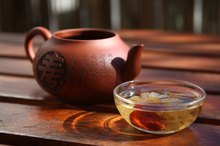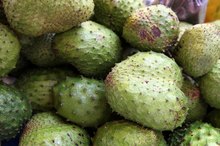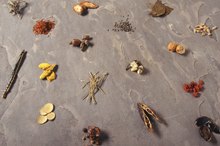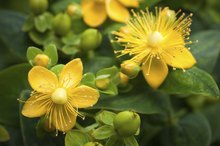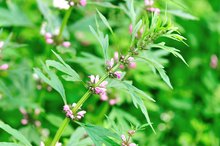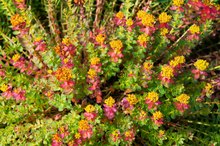Common Herbs With MAO Inhibitor Activity
MAOs, or monoamine oxidases, are enzymes that break down neurotransmitters and stop their messaging activity. MAO-A breaks down serotonin, epinephrine and norepinephrine; MAO-B deactivates dopamine. MAO inhibitors prevent the breakdown process, allowing neurotransmitters to remain available longer in the synapses between nerve sells. MAO inhibitors are prescribed for depression, but due to their dangerous interactions with certain foods, they have been largely replaced by other types of antidepressants. Herbs can inhibit MAO-A and MAO-B enzymes without the unpleasant side effects of antidepressants.
If you are experiencing serious medical symptoms, seek emergency treatment immediately.
Syrian Rue
Syrian rue (Peganum harmala) is a perennial herb found throughout the western and southwestern United States, Europe and the Middle East. The seeds and roots contain the alkaloids harmaline, harmine, harmalol, harmol and tetrahydroharmine. A study published in the 2009 issue of Food and Chemical Toxicology found that harmaline and harmine in the seed extracts of Syrian rue were potent MAO-A inhibitors; and harmine in the root extract was an active MAO-A inhibitor.
- Syrian rue (Peganum harmala) is a perennial herb found throughout the western and southwestern United States, Europe and the Middle East.
- A study published in the 2009 issue of Food and Chemical Toxicology found that harmaline and harmine in the seed extracts of Syrian rue were potent MAO-A inhibitors; and harmine in the root extract was an active MAO-A inhibitor.
Passionflower
Natural Alternatives to Larazapam
Learn More
Passionflower (Passiflora incarnata) is a perennial climbing vine with light blue flowers. It produces an edible fruit called maypop. Passionflower contains the MAO inhibitors harmaline and harmine. It also contains several flavonoids that are MAO inhibitors, including apigenin, kaempferol and quercetin.
- Passionflower (Passiflora incarnata) is a perennial climbing vine with light blue flowers.
- It also contains several flavonoids that are MAO inhibitors, including apigenin, kaempferol and quercetin.
Ayahuasca
Ayahuasca (Banisteriopsis caapi) is a South American vine noted for its hallucinogenic actions. It was used traditionally to treat parasites and digestive disorders. Ayahuasca is popular in research on potential cures for Parkinson’s disease because of its effects on MAO-B, which deactivates dopamine (the neurotransmitter lacking in Parkinson’s patients). A study reported in the 2010 issue of the Journal of Ethnopharmacology found that harmaline and harmine in ayahuasca are MAO-A and MAO-B inhibitors. It also found MAO-B inhibitory potential in the flavanols epicatechin and procyanidin. The strong MAO-B inhibitory action of ayahuasca point to a possible treatment for Parkinson’s disease 2.
- Ayahuasca (Banisteriopsis caapi) is a South American vine noted for its hallucinogenic actions.
- A study reported in the 2010 issue of the Journal of Ethnopharmacology found that harmaline and harmine in ayahuasca are MAO-A and MAO-B inhibitors.
Nutmeg
Dopamine Lowering Herbs
Learn More
Nutmeg (Myristica fragrans) is an evergreen tree native to the Spice Islands. The seed of the tree is called nutmeg, and mace is the seed covering. Nutmeg essential oil contains myristicin, which can be toxic in large doses. Myristicin is an unselective MAO inhibitor, meaning it acts on both MAO-A and MAO-B. Nutmeg also contains the MAO inhibitors kaempferol and quercetin.
- Nutmeg (Myristica fragrans) is an evergreen tree native to the Spice Islands.
- Nutmeg essential oil contains myristicin, which can be toxic in large doses.
Turmeric
Turmeric (Curcuma longa) is a yellow root used in Asian cooking and traditional medicine. A study reported in Psychopharmacology found that curcumin inhibited both MAO-A and MAO-B and increased the levels of serotonin and dopamine 3. When the researchers combined curcumin with piperine, an alkaloid found in black pepper, they found this enhanced the effect of MAO inhibition.
Kava
Kava (Piper methysticum) is a green shrub native to the Pacific Islands, where it's used as a relaxing beverage. The active ingredients in kava are called kava pyrones or kavalactones. A study in Pharmacopsychiatry found that six kavalactones were MAO-B inhibitors and increased dopamine levels in the brain. In order of potency, they are: desmethoxyyangonin, methysticin, yangonin, dihydromethysticin, dihydrokavain and kavain.
- Kava (Piper methysticum) is a green shrub native to the Pacific Islands, where it's used as a relaxing beverage.
- The active ingredients in kava are called kava pyrones or kavalactones.
Related Articles
References
- “Food and Chemical Toxicology”; beta-Carboline alkaloids in Peganum harmala and inhibition of human monoamine oxidase (MAO); Herraiz T, González D, Ancín-Azpilicueta C, Arán VJ, Guillén H; December 2009
- “Journal of Ethnopharmacology”; Banisteriopsis caapi, a unique combination of MAO inhibitory and antioxidative constituents for the activities relevant to neurodegenerative disorders and Parkinson's disease; Samoylenko V, Rahman MM, Tekwani BL, Tripathi LM, Wang YH, Khan SI, Khan IA, Miller LS, Joshi VC, Muhammad I; February 2010
- “Psychopharmacology”; Antidepressant activity of curcumin: involvement of serotonin and dopamine system; Kulkarni SK, Bhutani MK, Bishnoi M; September 2008
Writer Bio
Janet Contursi has been a writer and editor for more than 23 years. She has written for professional journals and newspapers, and has experience editing educational, cultural, and business articles and books. Her clients include Gale Publishers, Anaxos, Vielife and Twin Cities Wellness. Contursi earned her Ph.D. at the University of Minnesota, where she studied cultural anthropology, South Asian languages and culture, and art history.
